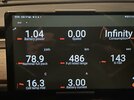Thats not right.
Calendar aging is like [SOC x Temp x time]
Look at the NCA cells (panasonic NCA, like teslas), most common in Teslas. You can see that the degradation cut in half between 55 to 60%. In reality there is a fixed point at about 57% for a new NCA battery. Aging moves this point slightly upwards but fast charing moves it down.
The calendar aging is dependent on swuare root of time, so for exampe using 80-90% charge ands driving only 20% will keep the SOC on the high side. After four years(48 months) you will have a calendar aging of: 5 x square root(48/10)= 11% cyclic aging.
View attachment 934950
No, you wont.
If you do full cycles, like 100% to 0%, the same cells as in the picture above will degrade like this:
The chart marked 4.2V is run 100% to 0%, thats the true 0% = 4.5% below Teslas 0% on the screen. In a Tesla this is about the time when a Tesla already has stopped running and is shutting down.
You get about 800 full cycles, for 0.5A-0.7A which is 0.2-0.3C or about the driving power of a tesla.
800 cycles 100-0% would be 800 x 400km = 320.000 km. During this cycles, 25% capacity is lost.
A normal car does about 10-20K km per year. Lets say 20K then. This is 50full cycles each year. The degradation for these very big cycles is 50/800*25 = 1.56% each year, so 6.25% for four years.
For these four years of 80% SOC, with large cycles calendar aging would be 11% and cyclic aging 6.25%
With smaller normal cycles, the annual cyclic degradation is only a fraction so most 4 year old cars charged to 80-90% will have about 11-12% total degradation, of which 11% is calendar aging.
View attachment 934951



